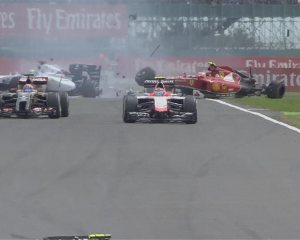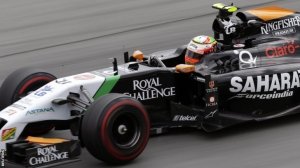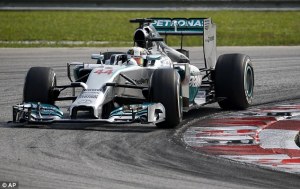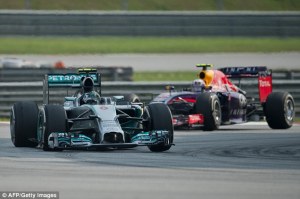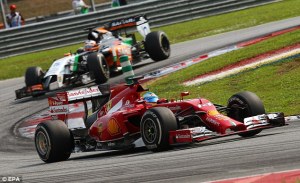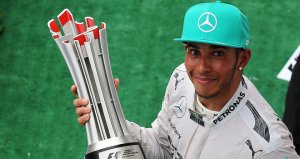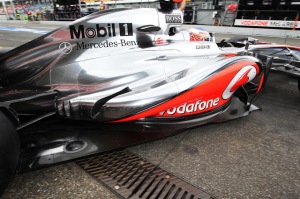Speculation about possible driver moves provides an almost constant backing track to life in the Formula 1 paddock, a backing track that is never quite drowned out by the roar of F1 engines. In 2012, this background music has been particularly loud, due primarily to the fact that one driver in each of the ‘big four’ teams was out of contract at the end of the season. With the news that one of those drivers – Red Bull Racing’s Mark Webber – has decided to stay where he is for 2013, announcing a one year contract extension earlier this week, where does that leave things for the other three drivers still ‘in play’ and potentially in the hunt for a new seat: Mercedes driver Michael Schumacher, McLaren’s Lewis Hamilton and Ferrari’s Felipe Massa?
Let’s start with Felipe Massa. The Brazilian’s struggles over the past few seasons have been well documented. He has not won a race since his home grand prix in 2008 – the very same race that he lost out on the world drivers’ championship to Lewis Hamilton – and he has been comprehensively outpaced by Fernando Alonso since the Spaniard joined the team in 2010. Massa failed to finish on the podium in the whole of the 2011 season and, up until the British grand prix, Massa’s 2012 campaign had been equally lacklustre, with just two top 10 qualifying slots in the opening eight rounds of the season, and three points scoring race finishes. Massa’s performance at Silverstone was, though, a dramatic change in his fortunes and by far his best race weekend of the season. A fifth place grid slot represented his best qualifying position of the season and a fourth place finish in the race, with strong pace throughout, was clearly his best Sunday performance of the season, and his best race result.
Given his dismal 2011 season, Massa was already under pressure going in to 2012, with speculation that he would leave Ferrari almost ever present. His performances in the opening eight rounds of the season led to rumours that Ferrari would dispense with his services before the season was out but, thus far, that has proved not to be the case. Now that there’s been an upturn in his form with the result at Silverstone, is there now a possibility that Massa could even stay with the Scuderia beyond the end of the current campaign? The answer to that question is that yes, it’s a possibility, but despite the supportive comments from Ferrari President Luca di Montezemolo and team principal Stefano Domenicali following Massa fourth place finish at Silverstone I expect that the possibility is probably a fairly remote one unless Massa can maintain his improved form over the remaining 11 races of the season. In my view, Massa would, at the very least, need some podium finishes to stand a chance of retaining his seat. Even that might not be enough though; I suspect that Ferrari may well have already made up their mind on Massa and that the exit door beckons.
Moving on to Michael Schumacher, who is in the final year of his three year contract with Mercedes AMG F1. Schumacher hasn’t enjoyed the most successful time of his career since returning to the sport in 2010. Admittedly, the Mercedes, until this year, hasn’t been a winning car, but in both 2010 and 2011 Schumacher was outpaced by his young team-mate, Nico Rosberg. Even in 2012, Rosberg enjoys a huge points advantage over his seven time world drivers’ championship winning team-mate, having won the Chinese grand prix. Schumacher, in contrast, had only scored a meagre two world championship points up until the European grand prix at Valencia; round eight of the championship. This, though, does not tell the full story of Schumacher’s season. He’s had five retirements in nine races, four of which were mechanical failures, like the bizarre jammed DRS in Canada. He has also scored his first podium finish since his return to F1, with third in Valencia and he also drove a brilliant qualifying lap in Monaco to take pole position (although a grid penalty meant he started sixth). There are, therefore, certainly signs of an upturn in form for Schumacher, and this being the case I would expect that he would want to stay on in Formula 1 for one more year in the hope that Mercedes can provide him with a car that’s capable of delivering another world driver’s championship.
The only question that remains for Schumacher is whether Mercedes would want to keep him beyond the end of his current contract. The answer to that question is an emphatic ‘yes’. Despite Schumacher being 43 years of age (he will be 44 before the start of next season), Mercedes team principal Ross Brawn was quite clear when discussing possible driver options in 2013 that Schumacher was very much the first choice. Brawn was quoted as saying, ahead of the British grand prix, “We are focused on Michael for as long as it takes – and for whatever it takes”. Let’s not forget that Schumacher and Brawn have a long and distinguished working relationship having delivered world championships together for both Benetton and Ferrari. It’s no surprise that Brawn would like to continue what has been an enormously successful working relationship with Schumacher. Given these factors, I expect that Schumacher will stay with Mercedes in 2013, but probably not far beyond that season.
McLaren’s 2008 world drivers’ champion, Lewis Hamilton, is also out of contract at the end of the current season. Given the team’s well documented issues with pit procedure, strategy and, following the British grand prix, outright pace, many have speculated that Hamilton will take the decision to move on from the team that brought him into Formula 1 at the age of 22, the same team that has been supporting his development since the age of 13. Hamilton has been linked with drives at all of the front-running teams. There have been rumours of a move to Red Bull, Ferrari, Mercedes and even Lotus. We now know, of course, with Mark Webber’s decision to re-sign with Red Bull for 2013, that the opportunity of a move to the reigning world constructors’ champions is not going to materialise, at least not this year. With Mercedes being quite clear that they will retain Michael Schumacher, if the seven time world drivers’ champion decides he wants to carry on racing at the highest level, the possibility of a move to the Brackley-based team for Hamilton is still possible, but one suspects that the idea of being second choice behind Schumacher would not be particularly appealing to the Englishman.
The possibility of Hamilton replacing Felipe Massa at Ferrari – if, as I suspect, the Brazilian does not stay on with the team beyond the end of the current season – is an extremely remote one, in my view. Given that Fernando Alonso has already said that he gets some say over who will be his team-mate at the Italian team, it would be incredibly hard to imagine him rubber stamping Hamilton as his team-mate. The memory of Hamilton and Alonso as team-mates at McLaren in 2007 – Hamilton’s rookie year in Formula 1 – is still relatively fresh. The relationship between the team-mates was not good and as they battled it out for supremacy in what was probably the fastest car that season. That at times bitter inter-team battle ultimately allowed Kimi Raikkonen take the world drivers’ championship for Ferrari, who also took the constructors championship that year. Despite having agreed a multi-year contract, Alonso left at the team at the end of that campaign, returning to Renault for two seasons, before moving on to join Massa at Ferrari in 2010.
With no seat at Red Bull, Schumacher the first choice to stay on for another year at Mercedes, and Alonso highly unlikely to countenance having Hamilton as his team-mate at Ferrari, the Englishman is left with very few worthwhile options for 2013. In my view, the speculation about a move to Lotus is not credible, which leaves staying at McLaren as the 2008 world drivers’ champion only realistic choice. This is exactly what I expect Hamilton to do, despite the team’s recent struggles. Don’t forget, too, that despite the speculation about Hamilton leaving McLaren, there has been a notable lack of speculation about who might take his seat at McLaren if he did decide to leave. This is in stark contrast to the Massa/Ferrari situation, and this contrast, in my view, gives an indication about the relative likelihood of Massa and Hamilton leaving their respective teams. It’s also easy to under-estimate the value of loyalty, but I think that this, along with McLaren’s position as one of F1’s top teams over the past few decades, will mean that Hamilton stays with the Woking-based outfit. After 14 years affiliated with the team that stood by him in 2011, despite his own troubled season, I would expect that it would take more than a disappointing start to 2012 – don’t forget that there’s still over half of the season to go – to persuade Hamilton that his future lies away from McLaren. The length of any new deal for Hamilton at McLaren will, though, be extremely interesting.
So, with Mark Webber definitely staying at Red Bull Racing for 2013, and assuming that my other assumptions are correct, who will race alongside Fernando Alonso at Ferrari in 2013? The most credible drivers to be linked with a drive with the Italian team are Force India’s Paul di Resta and Sauber’s Mexican driver Sergio Perez. For me the most logical option is Perez. He’s a Ferrari development driver and despite Ferrari Driver Academy head Luca Baldisserri saying recently that he was “too aggressive” and Luca di Montezemolo saying “to drive a Ferrari you need more experience”, I can’t see Ferrari turning anywhere else if they replace Massa. As I mentioned, di Resta is the other current F1 driver that’s been linked with Ferrari, but I can’t see that happening. Di Resta is a Mercedes protégé, and if he moves from Force India, the only place that I could see him going would be to the Mercedes works team, possibly to replace Schumacher in 2013 if the German decides to retire again. The other possibility for the Mercedes drive, if Schumacher decides against continuing in Formula 1, is di Resta’s Force India team-mate Nico Hulkenberg, but as I’ve already said, I do expect Schumacher to stay on with Mercedes for another year.
The other big question mark for 2013 is Bruno Senna’s position at Williams. Williams’s upturn in form in 2013 has been notable, and all of a sudden the Grove-based team are a more desirable place to be in 2013. Senna was only confirmed at Williams for 2012 and while he has been consistent and a steady points scorer, his performances have not been as spectacular as many fans of his uncle, the late, great triple world drivers’ champion, Ayrton Senna, had hoped for. There has been a lack of speculation about Williams and Senna and their plans for 2013 thus far, but I expect that to change as other drivers’ and teams’ plans for 2013 become clearer.
I might be completely wrong about all of my predictions for drivers and teams for 2013, of course. Schumacher might choose to retire. Massa might have a brilliant second half of the season. Hamilton’s contract talks with McLaren might reach an impasse. Only time will tell where everyone ends up when the music stops…
